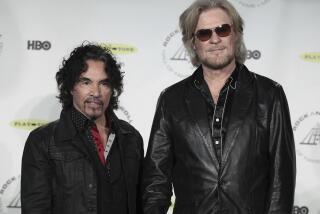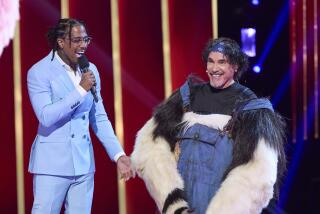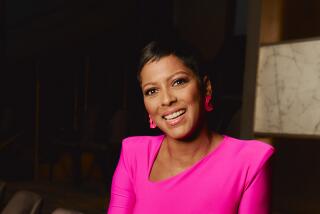Hall & Oates’ Blue-Eyed Stroll in O.C.
- Share via
SANTA ANA — The hits just kept on coming at Hall & Oates’ concert Tuesday, the first of a two-night stand at the Galaxy Concert Theatre.
This was hardly a surprise, considering the most commercially successful duo in rock history can choose from 29 top-40 hits. And because the once-prolific group’s most recent album of new material, the acoustic-slanted “Change of Season,” came out in 1990, the decision to focus on their best-known songs had to come easy.
The 100-minute show served as a tidy encapsulation of John Hall and Daryl Oates’ life as pop-chart kingpins. Incredibly, the duo proved it hasn’t changed much since its heyday of hits, from 1976 to 1985.
The Philadelphia-bred group, augmented by a solid if unspectacular five-piece band, offered its blue-eyed rock ‘n’ soul with the same efficiency and professionalism found on their many albums. Lead vocalist Hall sounded utterly familiar on numbers such as the quasi-Motownish “Maneater” (a No.-1 single in 1982), singing with the youthful sass of old.
But the duo’s ability to duplicate the spirit and precision of such radio-ready hits was not always a blessing. Though the ballads “She’s Gone” and “Sara Smile” sounded as vibrant and fresh as they did back in 1976, other chart-scalers such as “Kiss on My List” and “One on One” proved as dubiously heartless as ever.
The Galaxy show served as a reminder that most of Hall & Oates’ popular material hasn’t gained much stature over the years. Never the critics’ darlings, they will likely be remembered as a sometimes pleasant and only occasionally soul-stirring pair who happened to achieve massive popular success.
As an R&B-tinged; rock or pop singer, Hall can be exciting and dynamic. But when his vocals strayed too far into the sweet soul music he so obviously loves, excessive drama ensued. When the band dived into an extended version of the ‘70s ballad “Me and Mrs. Jones,” Hall’s singing approximated the vocal hysterics of Michael Bolton, a far cry from the sensual crooning of the song’s original singer, Billy Paul. Al Green or Marvin Gaye never had to work that hard to impress an audience.
With Hall clearly in the role of main man, Oates contributed vocal harmonies and rhythm guitar, stepping out front to handle lead vocals on the rather pedestrian “How Does It Feel to Be Back.”
Hall and Oates also performed three new songs from an album to be released in the near future, Hall promised. With a little luck and promotion, one of them, a driving pop-soul tune, could become the duo’s 30th in the top 40.
More to Read
The biggest entertainment stories
Get our big stories about Hollywood, film, television, music, arts, culture and more right in your inbox as soon as they publish.
You may occasionally receive promotional content from the Los Angeles Times.









